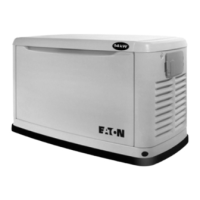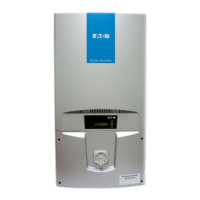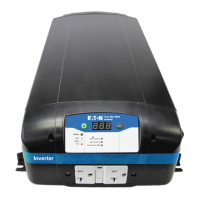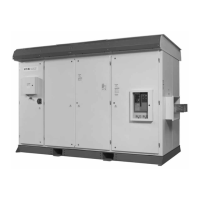12
General Information
Generator exhaust contains DEADLY carbon monoxide gas. This
dangerous gas can cause unconsciousness or death. Do not place
the unit near windows, doors, fresh air intakes (furnaces, etc.) or
any openings in the building or structure, including windows and
doors of an attached garage.
If the AUTO/OFF/MANUAL switch is not set
to its OFF position, the generator can crank
and start as soon as the battery cables are
connected. If the utility power supply is not
turned off, sparking can occur at the battery
posts and cause an explosion.
1.13 BATTERY REQUIREMENTS
See the Specifications section for correct battery size and rating.
1.14 BATTERY INSTALLATION
Fill the battery with the proper electrolyte fluid if necessary and
have the battery fully charged before installing it.
Before installing and connecting the battery, complete the follow-
ing steps:
1. Set the generator's AUTO/OFF/MANUAL switch to OFF.
2. Turn off utility power supply to the transfer switch.
3. Remove the 7.5A fuse from the generator control panel.
Battery cables were factory connected at the generator (Figure
1.11). Connect cables to battery posts as follows:
4. Connect the red battery cable (from starter contactor) to the
battery post indicated by a positive, POS or (+).
5. Connect the black battery cable (from frame ground) to the
battery post indicated by a negative, NEG or (—).
6. Install the battery post covers (included).
NOTE:
Dielectric grease should be used on battery posts to aid in the
prevention of corrosion.
NOTE:
Damage will result if battery connections are made in reverse.
Figure 1.11 – Battery Cable Connections
NOTE:
In areas where temperatures regularly fall below 32° F (0° C) it
is recommended that a pad type battery heater be installed to
aid in cold climate starting.
1.15 THE BATTERY
DO NOT dispose of the battery in a fire. The
battery is capable of exploding.
A battery presents a risk of electrical shock
and high short circuit current. The following
precautions are to be observed when work-
ing on batteries:
• Remove the 7.5A fuse from the generator con-
trol panel.
• Remove watches, rings or other metal objects.
• Use tools with insulated handles.
• Wear rubber gloves and boots.
• Do not lay tools or metal parts on top of the
battery.
• Disconnect charging source prior to connecting
or disconnecting battery terminals.
DO NOT open or mutilate the battery.
Released electrolyte has been known to
be harmful to the skin and eyes, and to be
toxic.
The electrolyte is a dilute sulfuric acid that
is harmful to the skin and eyes. It is electri-
cally conductive and corrosive.
The following procedures are to be observed:
• Wear full eye protection and protective clothing.
• Where electrolyte contacts the skin, wash it off
immediately with water.
• Where electrolyte contacts the eyes, flush thor-
oughly and immediately with water and seek
medical attention.
• Spilled electrolyte is to be washed down with
an acid neutralizing agent. A common practice
is to use a solution of 1 pound (500 grams)
bicarbonate of soda to 1 gallon (4 liters) of
water. The bicarbonate of soda solution is to
be added until the evidence of reaction (foam-
ing) has ceased. The resulting liquid is to be
flushed with water and the area dried.
Lead-acid batteries present a risk of fire
because they generate hydrogen gas. The fol-
lowing procedures are to be followed:
• DO NOT SMOKE when near the battery.
• DO NOT cause flame or spark in battery area.
• Discharge static electricity from body before
touching the battery by first touching a ground-
ed metal surface.

